Lewin Benjamin (ed.) Genes IX
Подождите немного. Документ загружается.

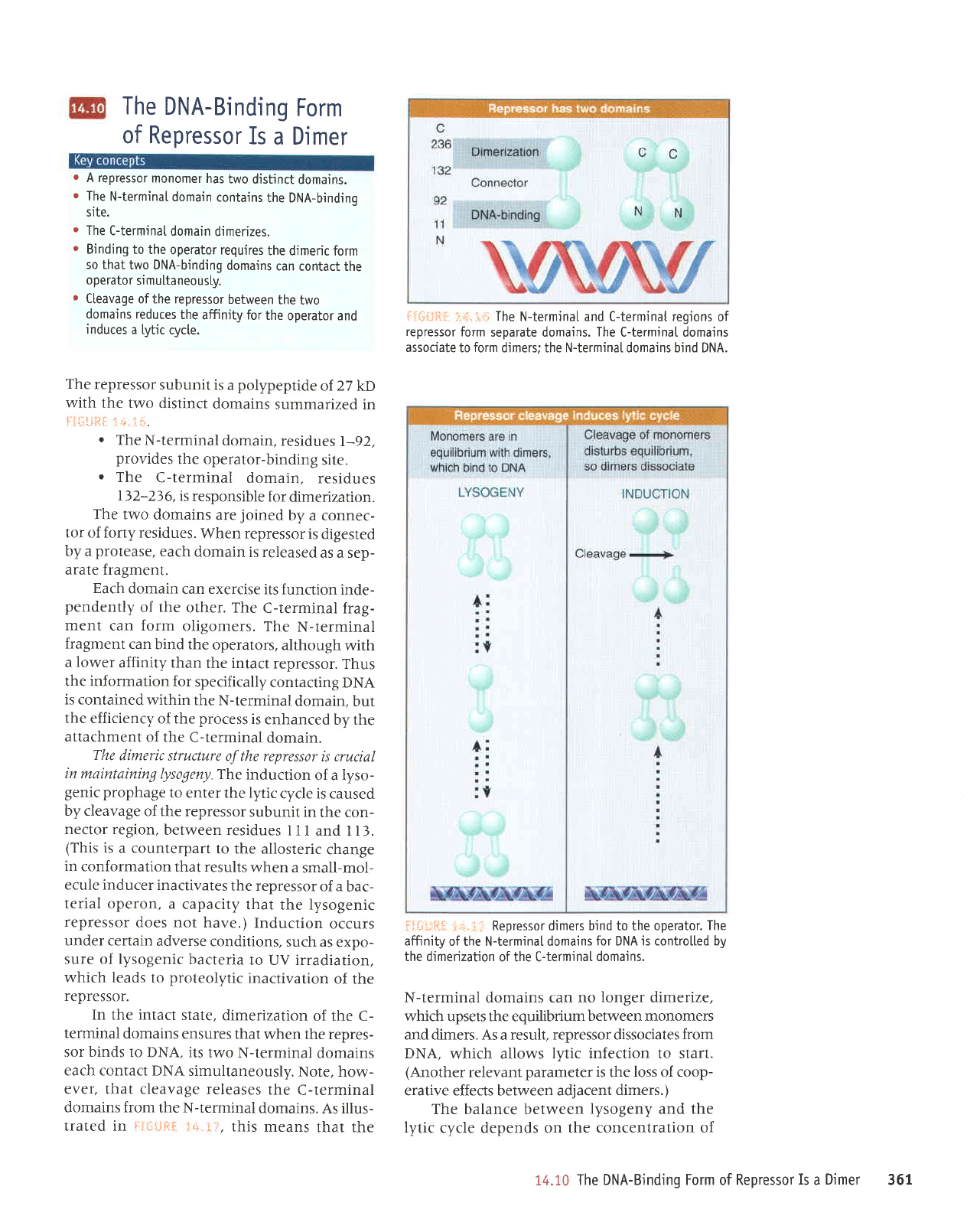
The
DNA-Binding
Form
of Repressor
Is
a Dimer
r
A repressor
monomer
has
two
distinct
domains.
o
The
N-terminaI
domain
contains
the DNA-bindinq
site.
r
The
C-terminal
domain
dimerizes.
o
Binding
to the
operator requires
the dimeric
form
so that
two DNA-binding
domains
can
contact the
operator
simultaneousty.
r
Cleavage of
the
repressor
between
the
two
domains reduces
the
affinitv for
the
operator and
induces
a lytic
cycte.
The
repressor
subunit
is a
polypeptide
of 27
kD
with
the two distinct
domains
summarized
in
!:?GLiR[ -!'.:.i.fi.
.
The
N-terminal
domain,
residues
l-92,
provides
the operator-binding
site.
.
The
C-terminal
domain,
residues
I)2-236, is
responsible
for
dimerization.
The two
domains
are
joined
by a connec-
tor of forty residues.
When repressor
is dige
sted
by
a
protease,
each
domain
is released
as a sep-
arate fragment.
Each
domain
can exercise
its
function
inde-
pendently
of the
other. The
C-terminal
frag-
ment
can form
oligomers.
The
N-terminal
fragment
can
bind the
operators,
although
with
a lower
affinity than
the intact
repressor.
Thus
the
information
for
specifically
contacting
DNA
is contained within
the
N-terminal
domain,
but
the efficiency
of the
process
is
enhanced
by the
attachment
of the
C-terminal
domain.
The
dimeric
structure
of the repressor
is crucial
inmaintaining
lysogeny
The induction
of a lyso-
genic prophage
to
enter the
lytic
cycle is caused
by cleavage
of the repressor
subunit in
the con-
nector
region,
between residues
I
I I and t
13.
(This
is a counterpart
to the allosteric
change
in conformation
that results
when a
small-mol-
ecule inducer
inactivates
the repressor
of a
bac-
terial
operon, a
capacity
that the lysogenic
repressor
does
not have.)
Induction
occurs
under certain
adverse
conditions,
such as
expo-
sure of lysogenic
bacteria
to UV irradiation,
which leads
to
proteolytic
inactivation
of the
repressor.
In the intact
state,
dimerization
of the C-
terminal
domains
ensures
that
when the repres-
sor binds
to DNA, its
two
N-terminal
domains
each contact DNA
simultaneously.
Note, how-
ever, that cleavage
releases
the
C-terminal
domains from
the N-terminal
domains.
As illus-
trated in
ri*',lRF
i.4"::.',
this
means
that the
ti;i;iJi{i:
,:
+.I
r
The
N-terminaI and C-terminat regions of
repressor
form
separate domains.
The
C-terminaI domains
associate
to
form
dimers; the N-terminal domains bind DNA.
Fli:t'!ll
:r.,.1; Repressor dimers bind to the operator.
The
affinity
of the N-terminaI domains
for DNA is controlted by
the dimerization
of the C-terminaI
domains.
N-terminal
domains
can no longer dimerize,
which
upsets the equilibrium
between monomers
and dimers. As
a
result, repressor dissociates
from
DNA,
which allows
lytic infection to start.
(Another
relevant
parameter is
the
loss of coop-
erative effects between adjacent
dimers.)
The balance between
lysogeny and the
Iytic
cycle depends on
the concentration of
14.10
The DNA-Binding Form of Repressor
Is
a
Dimer
361
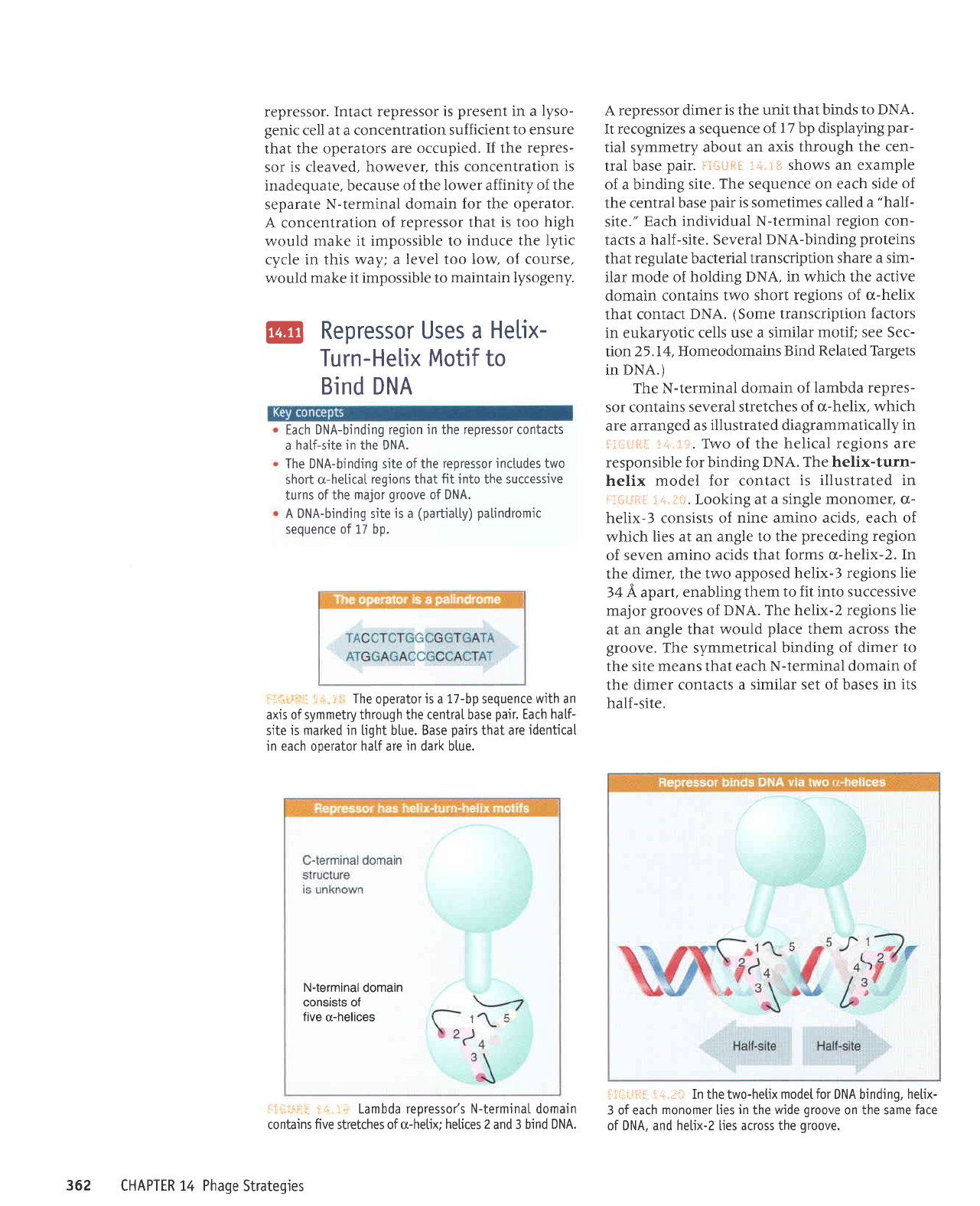
repressor.
Intact repressor
is
present
in a
lyso-
genic
cell at a concentration
sufficient
to ensure
that the operators
are occupied.
If
the
repres-
sor
is cleaved, however,
this concentration
is
inadequate, because
of the lower affinity
of the
separate
N-terminal domain
for the operator.
A concentration
of repressor that
is too high
would
make it impossible to
induce the lytic
cycle in this way; a
level too low, of course,
would make it impossible to
maintain lysogeny.
A
repressor dimer
is the unit that binds
to DNA.
It recognizes
a sequence
of I
7
bp displaying
par-
tial symmetry
about
an axis through the
cen-
tral
base
pair. tir**ft{ :'""}* shows an example
of a binding
site.
The
sequence
on each side
of
the
central base
pair
is sometimes
called a
"half
-
site."
Each individual
N-terminal
region
con-
tacts a
half-site. Several
DNA-binding
proteins
that
regulate bacterial
transcription share
a sim-
ilar
mode of holding
DNA, in which the active
domain
contains
two short
regions of o-helix
that contact
DNA.
(Some
transcription
factors
in eukaryotic cells
use a similar
motif; see Sec-
tion25.I4,
Homeodomains
Bind
Related Thrgets
in DNA.)
The
N-terminal
domain of lambda
repres-
sor contains
several stretches of
u-helix, which
are
arranged as
illustrated diagrammatically
in
ri'"iit'il
li:i.iii. Two of
the helical regions are
responsible
for binding
DNA. The helix-turn-
helix model
for contact
is illustrated in
rr:r:t-iFl
':+"fti.
Looking at
a single monomer, o-
helix-3 consists of
nine amino acids, each of
which
lies at an angle to the
preceding
region
of
seven amino
acids that forms u-helix-2.
In
the
dimer, the two
apposed helix-3 regions
lie
34 A. apart,
enabling them
to fit into successive
major
grooves
of
DNA. The helix-2 regions
lie
at an angle that
would
place
them across
the
groove.
The symmetrical
binding of dimer
to
the site means that
each N-terminal domain of
the
dimer contacts
a similar set of bases in
its
half
-site.
i.i{j
i"J
fi i ii.
i"r.,
iii.i In the two-hetix model for DNA bi ndi n
g.
hetix-
3 of each
monomer
lies
in
the
wide
groove
on the same
face
of DNA, and helix-Z lies across the
qroove.
@
Repressor
Uses a
Helix-
Turn-Helix Motif to
Bind DNA
Each
DNA-binding region in the repressor contacts
a half-site in the DNA.
The DNA-binding site of the
repressor inctudes two
short a,-hetical
regions that
fit
into the successive
turns of the
major
groove
of DNA.
A DNA-binding site
is
a
(partial.ty)
pa[indromic
sequence of 17 bp.
:i:-
-..:i l:,. ..:.
The
operatorisa
L7-bpsequence with an
axis of symmetry through the centraI base
pair.
Each ha[f-
s'ite is marked in tight b[ue. Base
pairs
that are
identicaI
in each operator hatf are
in
dark btue.
iii.i1-rrilii ;.i :ii Lambda repressor's N-terminaI domain
contains five stretches ofo-hetix;
hetices 2
and 3 bind
DNA.
CHAPTER 14 Phage
Strategies
N-terminal
domain
consists of
five
s-helices
362
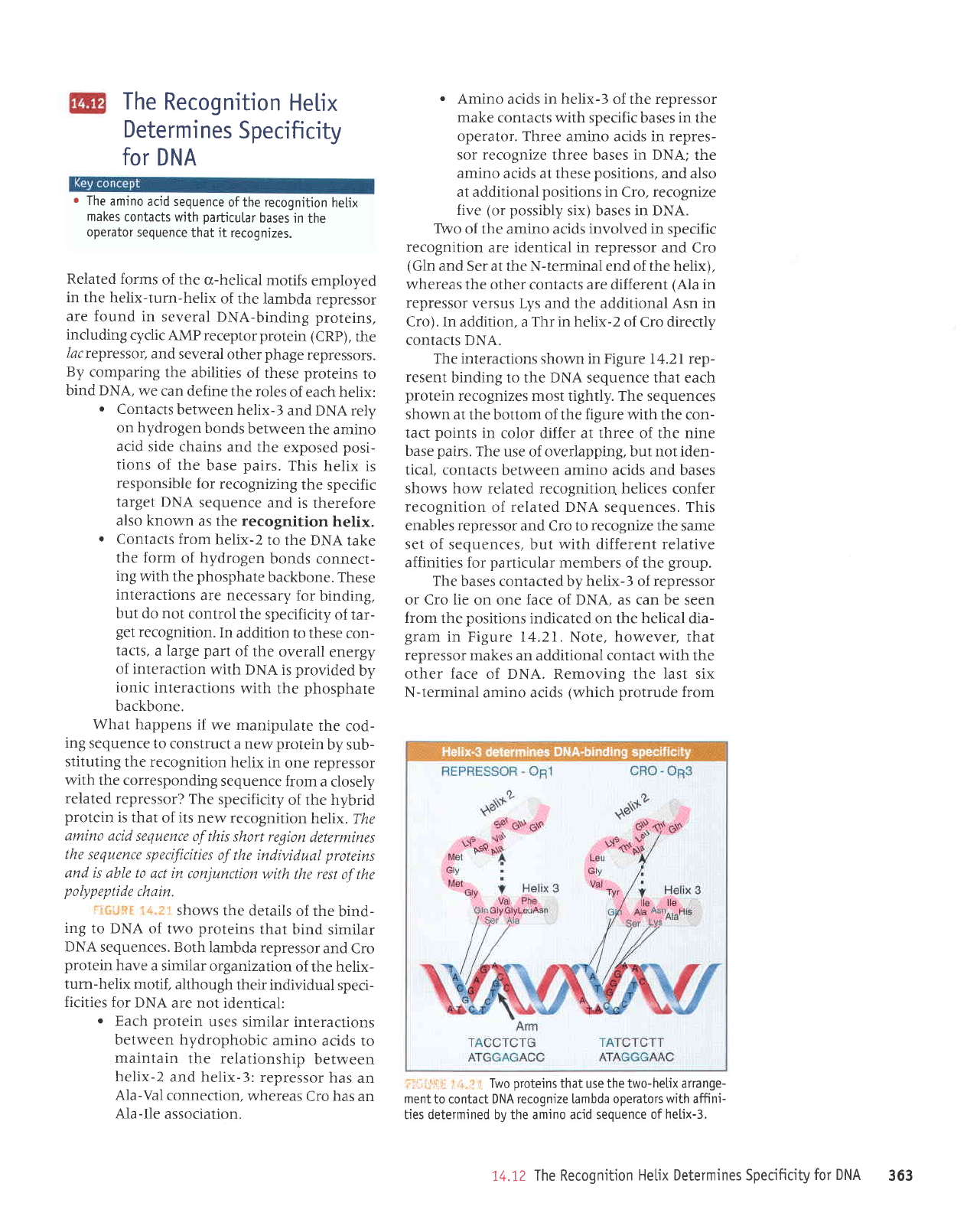
The
Recognition
Helix
Determines
Specificity
for
DNA
.
The
amino
acid
sequence
of the recognition
helix
makes
contacts with
particutar
bases in
the
operator
sequence
that it recognizes.
Related forms
of the
o,-helical
motifs
employed
in the
helix-turn-helix
of the
lambda
repressor
are found
in
several DNA-binding
proteins,
including
cyclic
AMP receptor protein
(
CRp),
rhe
/ac
repressor,
and
several
other
phage
repressors.
By
comparing
the abilities
of these
proteins
to
bind DNA,
we can
define
the roles
of
each helix:
o
Contacts
between
helix-l
and DNA rely
on hydrogen
bonds
between
the
amino
acid side
chains
and the
exposed posi-
tions
of the
base
pairs.
This
helix
is
responsible
for recognizing
the
specific
target DNA
sequence
and is
therefore
also known
as the
recognition
helix.
.
Contacts
from
helix-2
to
the DNA
take
the form
of hydrogen
bonds connect-
ing with
the
phosphate
backbone.
These
interactions
are necessary
for binding,
but do not
control
the
specificity
of tar-
get
recognition.
In
addition
to these
con-
tacts,
a large
part
of
the overall
energy
of interaction
with DNA
is
provided
by
ionic
interactions
with
the
phosphate
backbone.
What
happens if
we
manipulate
the
cod-
ing
sequence
to construct
a new
protein
by sub-
stituting
the recognition
helix
in
one repressor
with
the corresponding
sequence
from
a closely
related repressor?
The
specificity
of the hybrid
protein
is that
of its new
recognition
helix.
The
amino acid
sequence
of this short
region
determines
the
sequence specificities
of the individual
proteins
and is able to
act in conjunction
with
the rest
of the
nnlvnpntiip rhnin
i.
,
,.
r ,
shows
the details
of the
bind-
ing
to DNA
of two
proteins
that
bind
similar
DNA
sequences. Both
lambda
repressor
and
Cro
protein
have
a similar
organization
of
the helix-
turn-helix
motif, although
their individual
speci-
ficities
for DNA
are not identical:
.
Each
protein
uses similar
interactions
between hydrophobic
amino
acids to
maintain
the relationship
between
helix-2
and helix-3:
repressor
has
an
Ala-Val
connection,
whereas
Cro has an
Ala-Ile
association.
.
Amino
acids
in
helix-3 of the repressor
make contacts with
specific bases
in
the
operator. Three amino acids in repres-
sor recognize
three bases
in
DNA; the
amino
acids at these
positions,
and also
at additional
positions
in
Cro,
recognize
five
(or possibly
six) bases in DNA.
TWo
of the amino acids involved in specific
recognition
are identical in repressor
and Cro
(Gln
and
Ser at the N-terminal end of the helix),
whereas
the other
contacts
are
different
(Ala
in
repressor versus
Lys and the additional Asn in
Cro). In addition,
a
Thr in helix-2
of Cro directly
contacts DNA.
The
interactions shown in Figure 14.21 rep-
resent
binding to the DNA sequence that each
protein
recognizes most tightly. The sequences
shown at
the bottom of the
figure
with the con-
tact
points
in color differ at three of the nine
base
pairs.
The use of overlapping, but not iden-
tical, contacts
between amino acids and bases
shows
how related recognitioq helices confer
recognition
of
related DNA sequences. This
enables repressor
and Cro to recognize the same
set of sequences,
but
with different relative
affinities for
particular
members
of the
group.
The
bases contacted by helix-3 of repressor
or Cro lie
on one
face
of
DNA, as can be
seen
from
the
positions
indicated on the helical dia-
gram
in Figure
14.21
.
Note,
however,
that
repressor
makes an additional contact with the
other
face of DNA. Removing the last six
N-terminal
amino acids
(which protrude
from
:
rr,itrrrr
r
r,
, r
Two
proteins
that use the two-hetix arrange-
ment
to contact DNA recognize [ambda
operators with affini-
ties determjned by the amino acjd sequence
of heLix-3.
L4.1.2
Ihe Recognition
Helix Determines Specificity
for DNA
363
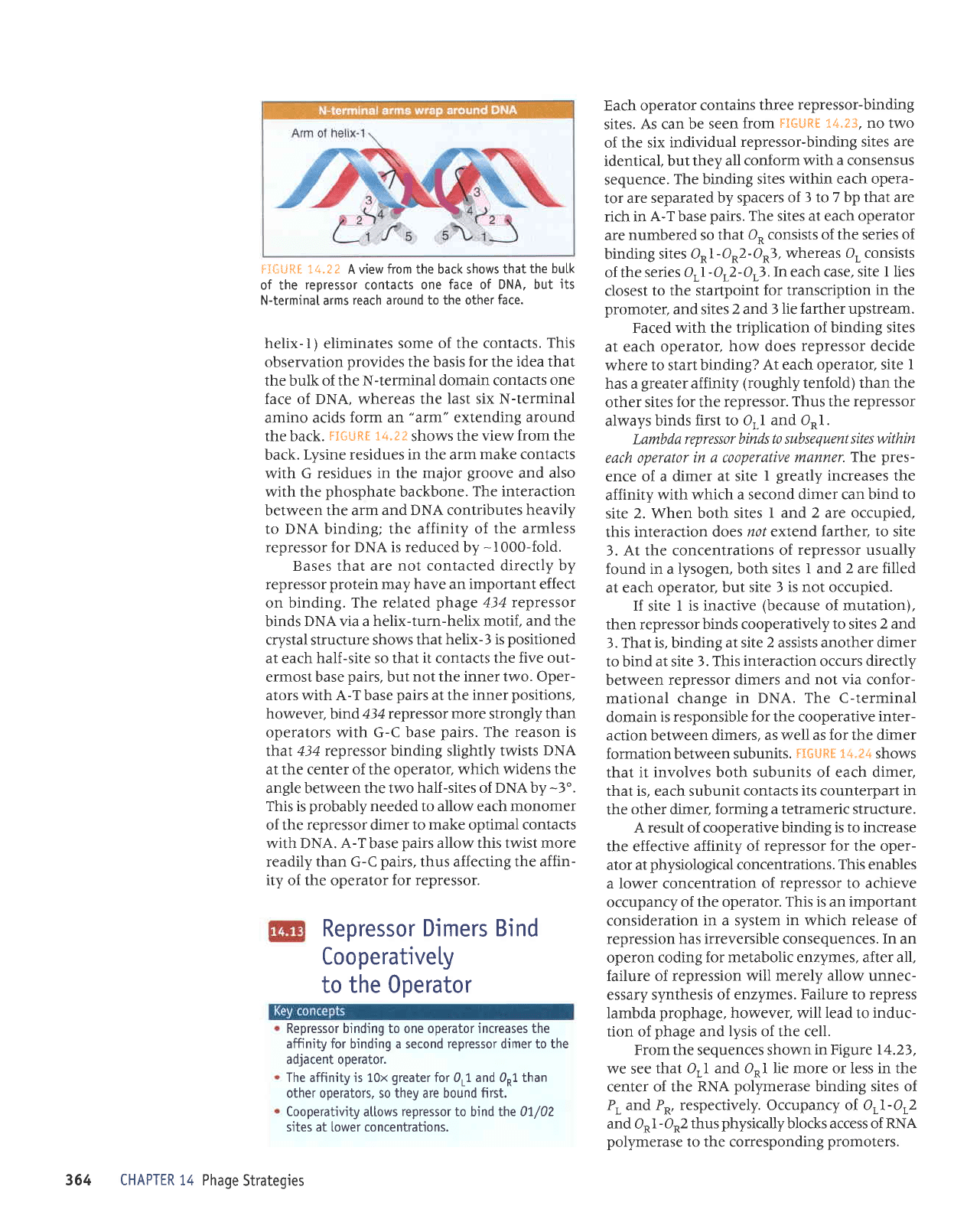
Repressor
Dimers Bind
CooperativeLy
to the 0perator
Repressor binding to one operator increases the
affinity for binding a second
repressor
dimer to the
adjacent operator.
The affinity is 10x
greater
for 0r1 and 0*1 than
other operators, so they are bound first.
Cooperativity
attows
repressor to
bind
the 07/02
sites at [ower concentrations.
Each operator
contains
three
repressor-binding
sites.
As can be
seen from
FI6i",Rf 14-33,
no two
of the six
individual
repressor-binding
sites are
identical,
but they all
conform with
a
consensus
sequence.
The binding sites
within each opera-
tor are
separated by
spacers of
I
to
7 bp that are
rich in
A-T base
pairs.
The sites at each operator
are
numbered so that
O* consists of the series
of
binding
sites O*1-O*2-OR3,
whereas O, consists
of the
series OLI-OL2-OL3.
In each case,
site I lies
closest to
the startpoint
for transcription
in the
promoter,
and sites
2 and3lie
farther upstream.
Faced
with the triplication
of binding sites
at each
operator,
how does
repressor decide
where to start
binding?
At each operator, site
I
has a
greater
affinity
(roughly
tenfold) than the
other
sites for the
repressor.
Thus the repressor
always binds
first to Orl
and o*I.
Lambda repressor
binds to subsequent
sites within
each operator
in a cooperative
manner. The
pres-
ence of a dimer
at site
I
greatly
increases the
affinity
with
which
a second dimer can bind
to
site 2. When
both sites
I and 2 are occupied,
this
interaction does
not extend farther,
to
site
3. At the concentrations
of
repressor usually
found in a lysogen,
both sites I and2 are
filled
at each
operator, but
site 3 is not occupied.
If
site
I is inactive
(because
of mutation),
then repressor
binds cooperatively to sites
2 and
3. That is, binding
at site 2 assists another dimer
to bind at site
3. This
interaction
occurs
directly
between
repressor
dimers and not via confor-
mational
change
in DNA. The C-terminal
domain
is responsible for the cooperative
inter-
action between dimers,
as well as for the dimer
formation
between subunits.
FISURS 14-24
shows
that it
involves both subunits of each dimer,
that is, each subunit
contacts its counterpart in
the
other dimer,
forming a tetrameric structure.
A result of cooperative binding
is to increase
the effective
affinity of
repressor for
the oper-
ator
at
physiological
concentrations.
This enables
a lower concentration
of repressor to achieve
occupancy
of the operator.
This is
an
important
consideration
in a system
in
which
release
of
repression
has irreversible consequences.
In
an
operon coding
for metabolic enzymes, after all,
failure of repression
will merely allow
unnec-
essary synthesis of
enzymes. Failure to repress
Iambda
prophage,
however, will
lead
to
induc-
tion of
phage
and
lysis
of the cell.
From the sequences shown
in
Figure 14.23,
we see
that O.l and O^l lie more or less in the
center of the
RNA
polymerase
binding sites of
P,
and
P*, respectively. Occupancy of. OrI-Or2
and O*
I
-O*2
thus
physically
blocks access of RNA
polymerase
to the corresponding
promoters.
lIGuftt 14.2t
A view
from the back shows that
the bul.k
of the
repressor
contacts
one face of
DNA, but
its
N-terminal arms
reach around to the other
face.
helix-l)
eliminates
some of the contacts.
This
observation
provides
the basis for the
idea that
the bulk of the N-terminal
domain contacts
one
face of DNA, whereas the
last six
N-terminal
amino acids
form an
"
arm" extending
around
the back.
FIGURE 14.22
shows
the view
from the
back.
Lysine residues in the arm
make contacts
with G residues in the
major
groove
and also
with the
phosphate
backbone.
The interaction
between the arm
and DNA contributes
heavily
to DNA binding; the affinity of
the armless
repressor for DNA is reduced by
-1000-fold.
Bases that are
not
contacted
directly by
repressor
protein
may
have
an
important effect
on
binding. The related
phage
434 repressor
binds
DNA
via a
helix-turn-helix motif, and
the
crystal structure shows that
helix-3 is
positioned
at
each
half-site so that it contacts the
five out-
ermost base
pairs,
but
not the inner two. Oper-
ators with A-T base
pairs
at the
inner
positions,
however,
bind434
repressor more strongly
than
operators with G-C
base
pairs.
The
reason is
that
434 repressor
binding slightly
twists
DNA
at the center of the operator, which
widens the
angle between the two
half
-sites
of DNA by
-3'.
This is
probably
needed to allow each monomer
of the repressor dimer
to make
optimal
contacts
with DNA. A-T base
pairs
allow this twist more
readily than G-C
pairs,
thus affecting the
affin-
ity of the operator
for repressor.
364 CHAPTER 14 Phage
Strategies
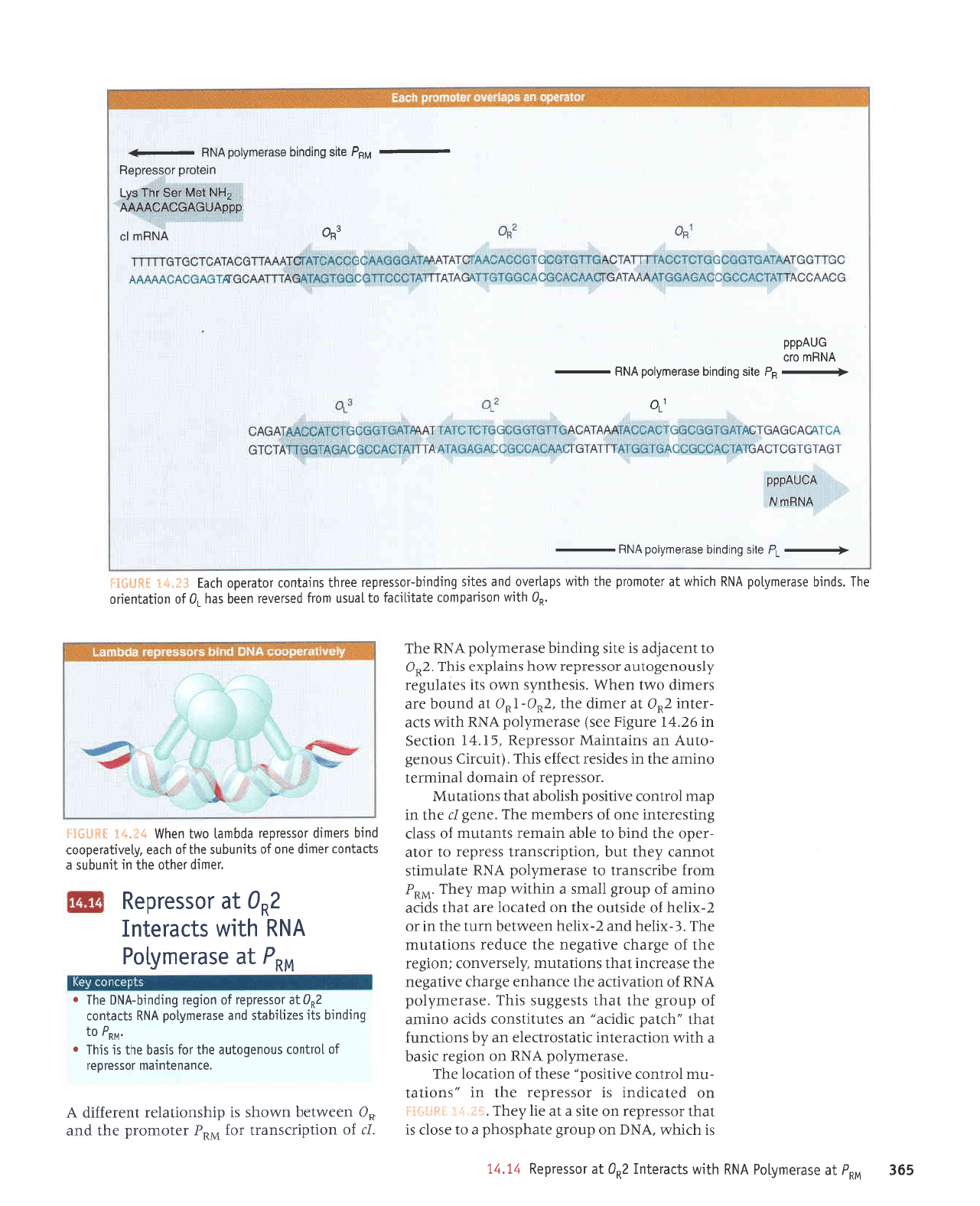
99€
wuot
1e
aserauAloa
VllU
qlrm
sllplalul
Zug
le
tossardaX
y1'71
sr
q)rqM
'vN(
uo
dnor8 areqdsoqd e ot
rsop sr
teql
rossardal
uo ells P
1e
JII ,(aq1
',;,,:'.i'
j
:1s:lrlili
uo
pJlpJrpur
sr rossardJt
Jql ur,,suorlel
-nlu
Iorluo)
arillrsod,, JSJqI
Jo
uorleJol aqJ
'aseraruLlod
VNU
uo uor8ar
;rseq
e
qlIM
uoll)eJelur lllelsorlJJle ue z{q suotnuny
teqt
,,qr1ed
f,rprJe,,
ue salnlrlsuo) sprJe
ourure
yo
dnorS
Jql
ter{l
stsaSSns
srql
'aserarudlod
VNU
Jo
uorlelrtf,p
Jql e)ueque aSreqr arrrte8au
eql
aseJJJur
leql
suorlelnru dlasranuor
luot8ar
aqt
Jo
a8reqr a,LrtB8au
eql JJnpal
suorlelnur
)r{J
'€-xlaq
pup
z-xleq
uaeMlJq urnl eql
ur Jo
z-xlleq
Jo
Jprslno Jql uo
pJterol
aJp
]eq]
sprJe
ourrue
yo
dnor8
llerus
e urqlrM deur
Laqg'wu7
ruoJJ eqrJJsupJl ot
aseJJru,{lod
VNU
Jlelntuus
louue)
.daqt
rnq
'uorldrnsuerl
ssardar
ol Jolp
-rado
aql
pulq
ot elqe urpuar
stuetnru
Jo
sselJ
Surtsaratur
Juo
Jo
sJaqruJru aq;
'aua8
p
aql ur
deru
lorluor
anrlrsod
qsqoqe
teqt
suorlelnw
'rossardar
Jo
urPuop
IeuruJel
ourure Jqt ur seprsJJ
DaJJa
s1q1
'(trnrrr3
snoua8
-otnv
ue surelurpw
rossardag
'SlVl
uortJJS
uI
9Z'
VI
a,rn8rg
aas) aseraruLlod
VNU
qllM
slJe
-ratur
gug
le
Jerurp Jql'Zuo-Iuo
lB
punoq
JJe
sJarurp o.l.rt uJqM
'srsaqluLs
uuo
str saleln8ar
,{lsnouaSol
n e ross:rd:r aroq sureldx J stqJ'ZuO
ot
tuarefpe
st atts Surpurq aseraru.{1od
vXu
aqt
'p
;o
uorldrr)sueJl
roJ
wud
raloruord eql
pue
uo
uaarvrlaq
uMoqs sr
drqsuotleleJ
ruerJJJIp
v
'oluPuelurerl.t
.rossa;da.r
Jo lolluol
snouebolne
aql roJ
stspq a!] st su.ll
r
.hlt4
ol
6urpurq slr
sazurqels
pue
eseraLuflod
VNU
speluol
7dg
1e
tossardar;o
uorber
6utputq-yp6 aq1
o
^'d
Ir
aselauAlod
vNU
qllM
stleralul
Za0
#
rossardau
laurp
laqlo 0q1 ur
lrunqns
e
sllpluol raurp
ouo
Jo
sltunqns
eql
Jo
qlea
'flearleradoor
purq
slaurp rossoldar
epquPl
oMl uaqM
9*'tE
$$fi*c*
't0
ql$
uosueduor
elpltltlPJ
ol
lensn
ulol1
pasla^al
uaeq
seq
rg
lo
uotleluauo
aql
'spurq
aserauAlod
VNU
qtlqm
1e
:aloLuord aql
ql$
sdelta,ro
pue
salrs burpurq-rosserda.l
aorql
sutPluol loletedo
qrel
Ii:"?E
SHfi$i{
13
alrs Durpurq esereurllod
y51g
VNHTUN
y3jyddd
,-o
-
H3
elrs burpurq asereurfi;od
VNH
-
vNHr.u
oJc
gqyddd
e"o
vNuur lc
dddvnOygCVCwVV
zHN
lel,\
rcg
rqi
sdl
urelojo
.rossoroau
eseteLurilodygg
+
V
_
y,lud
alts Dulpulq
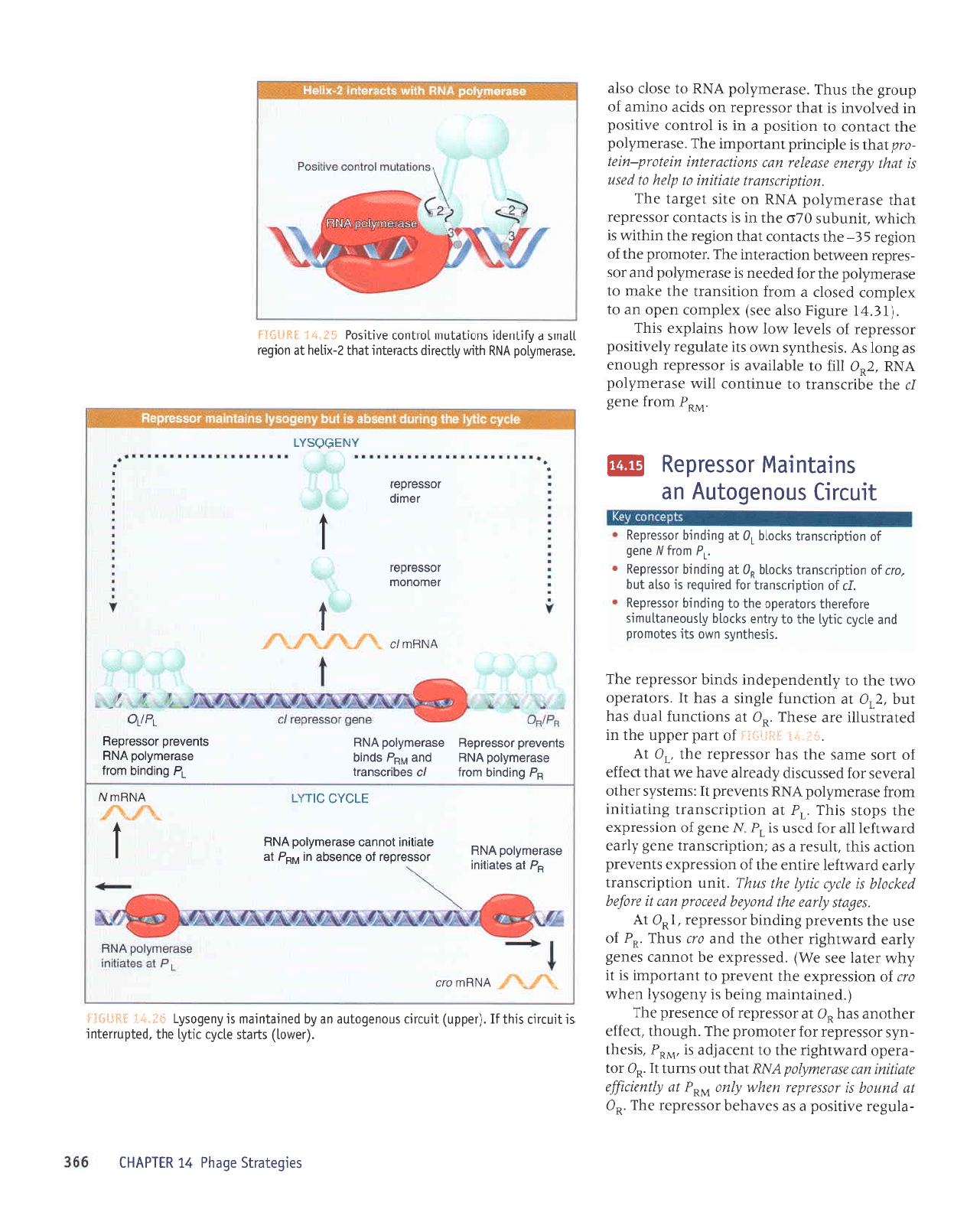
-eln8al
e^rtrsod
e sp
sJ^eqeq JossJJdJJ
JqJ
'uO
w
punlq
st Jzssaldat
uaq/yt [lul
^"d
io
[puan{ta
ap!ru!uat asutaw,{lodvttu
leqt
lno
surnl
1I'"o
rol
-erado
pre.Luq8rr
Jql ol
tuJ)efpe
sl
'^td
'srsJql
-u.{s
rossardet roJ
ratoruord
aq1
'q8noqr
'DJJJJ
raqloup
seq
uO
le
rossardar;o
aruasard
aq1
('paurelureur
Suraq sr LuaSosLl
uaqa,r
ol,
Jo
uorssardxa
aql
tuanard
ol
lueuodrur
sr
lr
Lq,t.:a1e1
aas
a14)
'passardxa
aq
touuer
saua8
.dgea
prea,ttq8rr
raqto
rqt
pue
or snql
'u4
;o
JSn eql stuanard
Surpurq
rossardar
'I
uO
ty
'sa6a1s
[1na atll puo[aq paantd
uat
y
atolaq
paryltq
st aph tpQ
ary snLlJ
'run
uortdrnsuerl
dlrea
pre.,vr1;JI
aJrtue Jqt
Jo
uorssardxa
slua,rard
uortJe
slql
'tlnsJr
e se
luorldrnsuerl
aua8 dFea
pJeMUJI
IIe
roJ
pJSn
sl
'd
N
auaS;o uorssardxa
aqt sdots
slqJ
']d
te
uorldrrlsuert
Surterllur
ruoJJ JSpJeLu,{1od
ylltrg
slua,tard
11
:sruats^ds
raqlo
IpJaAJs
JoJ
pJSSn)sp
Lpea.rle
a^eq J,lr
leql
tJeJJe
Io
lJos
Jrups
Jql seq
.rossardar
aqt
'161
ty
'::i:.'irl
riiji::i;.-i
;o
ged
raddn aqt ur
pJleJlsnllr
JJP JSaqJ
''o
]e
suorlrunJ
Ienp
spq
:rrq'ZaO
le
uollJunl
a13urs
e seq
11
'srolerado
oml eqt ol lltuapuadapur
spurq
:ossardar
aq1
'srsaqluAs
umo slr. selouotd
pue
alrr{r
rL1[1 aq1
o1 &1ua s1ro1q
flsnoaue]lnurs
ero1alaql
sloletado
aq1
o1 6urpurq rossatday
7'
Jo
uorl0utsupll
loJ
palrnbal
sr oslp
lnq
'o.r:1o
uoqdursuptl
sltolq
up
1e
6urpurq tossardaX
''d
tllolj
iV
auab
;o
uoqdursuerl qrolq
16
1e
6urpurq
tossetdaX
Irnljrl
snouabolnv
uP
sutPlutPW
rossatdau
@
'wu7
uror; aua8
1,
eql aqlJlsuerl
01 enurluoJ
lFlr
aserauLlod
17NU
'ZuO
IIrJ
ot alqelre.Le
sr rossardar q8noua
se 3uo1 sy
'srsaqlu.ds
umo
slr ateln8ar,{lanrlrsod
rossa,rdar
Jo
sle^Jl
zlrol Moq
sureldxa
srql
'(tE'f
t
arn8rg
osle
aas) xaldruor
uado
ue ol
xaldruor pasolJ
p
tuolJ
uorlrsuerl
Jql J>lptu
ol
aserauLlod
Jql
JoI
pJpJJu
sr ase,raru.{1od pue
ros
-sarda.r
ueJMlJq
uorDeJelut
JqI
'JJlotuoJd
aql
Jo
uor8ar
S€-
aqt spetuoJ
teqt
uor8ar
eqt uqtrm
sr
qrlrl.tr
'tlunqns
0Zo
Jqt
ur sr stJptuof,
rossardar
leqt
JserJru.{1od
y51g
uo
Jtrs
1a8re1
aq1
'uotldtttsua4
aryurut
o1 d1a4
q
pasn
st
pt11
f6nua
asaalal
uw
sulq)alalut
utalotd-uta1
-otd
tr-ql
sr
aldourrd
tueuodrur
aql
'ase.rarur{1od
Jql
lJeluoJ
o1 uorlrsod
e ur
sr
IoJluoJ
anrlrsod
ur
penlolur
sr
leql
rossardar
uo
sprf,p ourlup
Jo
dnor8
aqt snqJ
'eserJuz(1od
ygg
ot
JSoIJ oslp
sar6a1er15 abeq6
71
UlldVHl
'(remo1)
s1e1s
alrAr rrgl eq1
'paldnualur
srltnrlosrqlll'(laddn)
lLnuosnouabolneuefqpaurplureusLAua6osAl
$i1'- lt
.trS:trftil4
'esereuflod
ygX
qlrm
r\lparrp
sllplalur
lpql Z-xlleq 1e
uorber
11eLus
e AlLluapr
suorJplnu
lolluol
o^rlrsod
lA'rjt
;:lfE*i.l
vNuul
olJ
Hd
le
selelllu!
ese:etuIlod
y1g
losserder
Io
acuosqe u!
nud
le
olerlrur
louuec
esereu:{1od
ypg
flc^g
Cl
I
VNUTU N
Hg
6ulpu;q uo4
esereu{;od
ypg
sluanerd
.losserdeg
/c
saqucsuerl
pue
l\l
g
spu;q
eseretu{1od
ypg
rg
6u;pu;q uo4
asereufilod
ylg
sluenerd
.rosserdeg
1at1o
1l
vNuu.r /c
I
leuououl
rossoJoor
iatrllp
rossoJdo.l
I
ANf90SAl
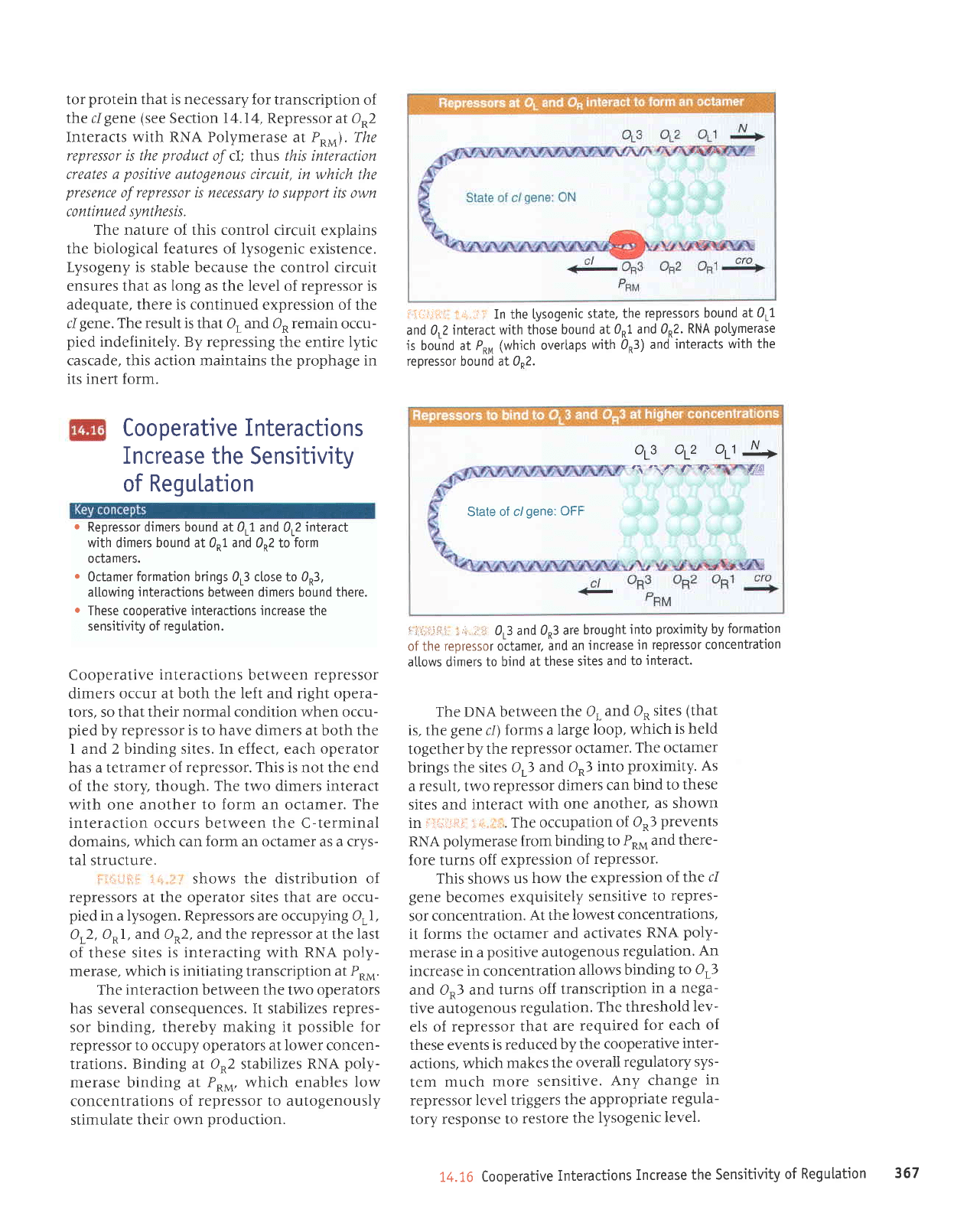
tor
protein
that is necessary
for transcription
of
the clgene
(see
Section 14.14,
Repressor at Oo2
Interacts with RNA Polymerase
at P**1 . The
represslr is
the
producl
o/ cI; thus this interaction
creates a
positive
autogenous circuit, in which
the
presence
of repressor is necessary
to support its own
continued
synthesis.
The nature oI this control
circuit explains
the biological
features
of lysogenic existence.
Lysogeny is stable because
the control circuit
ensures that as
long
as the level of repressor is
adequate, there is continued
expression of the
clgene. The
result is
that O. and O* remain
occu-
pied
indefinitely. By repressing
the entire lytic
cascade, this action maintains the
prophage
in
its inert form.
i:il..iii-ili
r,,.,:1
i
In the [ysogenic
state,
the
repressors bound
at 0r1
and 0r2 interact
with those bound
at
0*1 and 0R2.
RNA
potymerase
is bound at P*,
(which
overtaps
with 0*3)
and
interacts
with the
repressor bound at 0*2.
lii;'iiii1 i;,.i.;i'r 0r3 and
0*3 are
brought
into
proximity
by
formation
of the
repressor octamer,
ind
an increase
in
repressor concentration
attows dimers
to bind at
these sites
and to
interact.
The DNA between
the O,
and Oo
sites
(that
is. the
gene
c1)
forms alarge
loop,
which
is held
together by
the repressor
octamer.
The octamer
brings
the sites Or3
and
O*3
into
proximity. As
a result, two
repressor
dimers
can bind
to
these
sites and interact
with
one
another,
as shown
in
i:ii:l.irii i
;
:,::.
The occupation
of O*3
prevents
RNA
polymerase from binding
to
P** and
there-
fore turns off expression
of
repressor.
This
shows
us
how the
expression
of the
cI
gene
becomes
exquisitely
sensitive
to
repres-
sor
concentration.
At the
lowest
concentrations,
it forms the octamer
and
activates
RNA
poly-
merase in a
positive
autogenous
regulation.
An
increase in concentration
allows
binding
to Ot3
and O*3 and
turns
off transcription
in a nega-
tive autogenous
regulation.
The threshold
lev-
els of repressor
that
are
required
for each
of
these events
is reduced
by the
cooperative
inter-
actions,
which
makes the
overall
regulatory
sys-
tem
much more
sensitive.
Any
change
in
repressor level
triggers
the
appropriate
regula-
tory
response to
restore
the
lysogenic
level.
14.16
cooperative
Interactions
Increase
the sensitivity
of Regutation
367
Cooperative
Interactio ns
Increase
the Sensitivity
of ReguLation
o
Repressor dimers bound
at
0r1
and 0r2
interact
with dimers bound at 0*1 and 0*2 to
form
0cla
mers.
r
Octamer formation brings 0,3 ctose to 0*3,
a[[owing
interactions
between dimers bound there.
o
These cooperative interactions increase the
sensitivity of reg utation.
Cooperative
interactions
between
repressor
dimers
occur at both the left and right opera-
tors, so that
their normal condition
when
occu-
pied
by repressor
is
to
have
dimers at both the
I
and
2 binding sites. In effect, each operator
has a tetramer of
repressor.
This is not the end
of the story,
though. The two dimers interact
with one another
to form
an octamer.
The
interaction occurs between the C-terminal
domains,
which can form an octamer as a crys-
tal structure.
:
ii:.i:!i.
.
r
,
,
shows the distribution of
repressors at the operator sites that
are
occu-
pied
in a lysogen. Repressors are occupying O.1,
OL2,
ORI, and O*2, and the repressor at the
last
of these sites
is interacting with RNA
poly-
merase, which
is initiating
transcription
at Pono.
The interaction between the two
operators
has
several
consequences. It stabilizes
repres-
sor binding,
thereby making it
possible
for
repressor
to occupy operators at Iower concen-
trations. Binding
at
OR2 stabilizes
RNA
poly-
merase binding
at P*r, which enables low
concentrations
of repressor to autogenously
stimulate
their own
production.
oL3
ot2
or_1
J+
t'nnf
f
.F
f;f,
State of c/
gene:
OFF
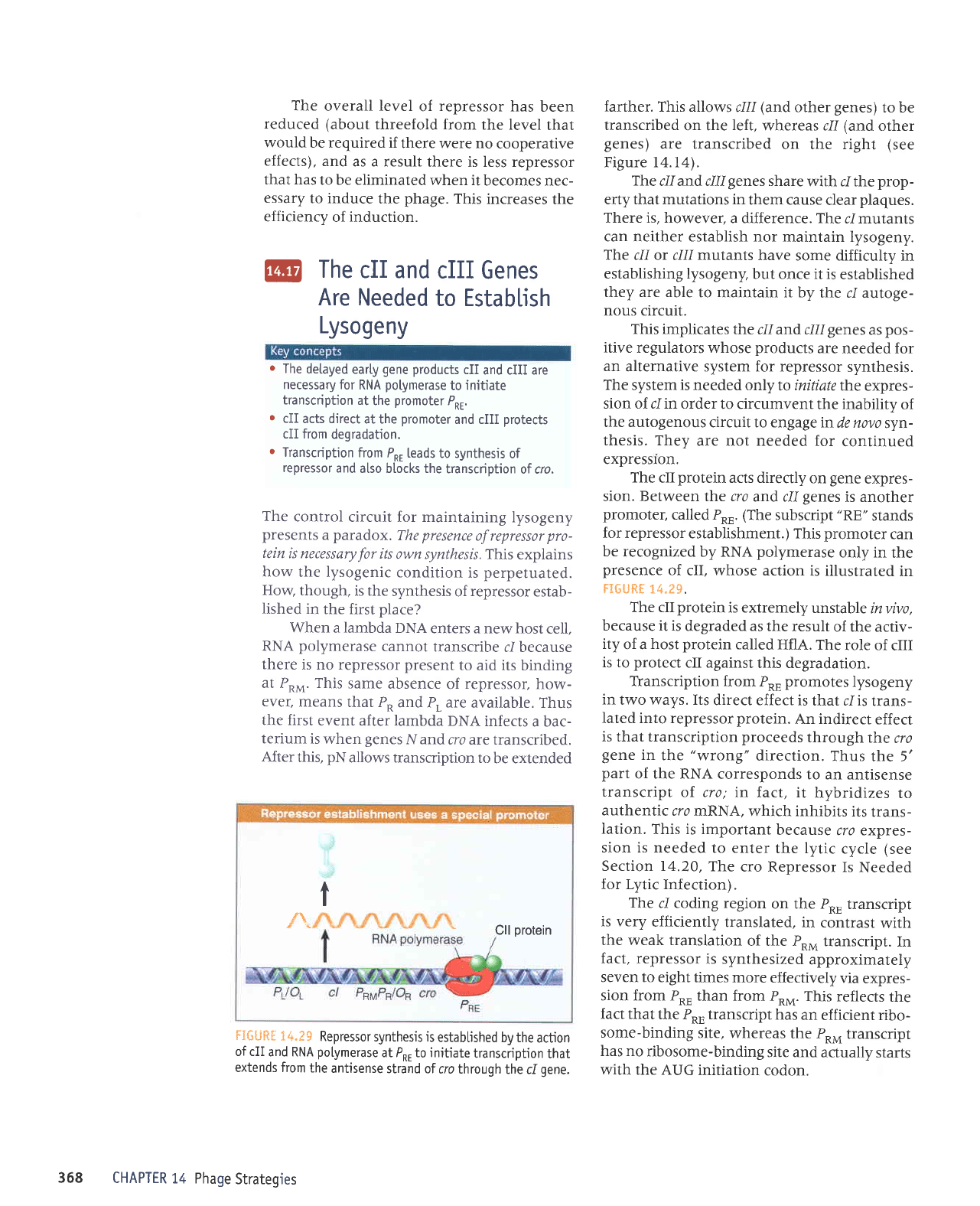
The
overall level
of
repressor
has
been
reduced
(about
threefold from
the level
that
would
be required if
there were no
cooperative
effects),
and
as a result
there is less repressor
that has
to be eliminated
when it
becomes nec-
essary
to induce
the
phage.
This
increases
the
efficiency
of
induction.
@
The
cII and
cIII
Genes
Are
Needed
to Establish
o
The
detayed
early
gene products
cII
and cIII are
necessary for
RNA
potymerase
to
initiate
transcription
at
the
promoter
P*r.
o
cII
acts direct
at the
promoter
and cIII
protects
cII from
degradation.
o
Transcription
from
P*, [eads
to synthesis
of
repressor
and
atso blocks the
transcription
of cro.
The
control
circuit for maintaining
lysogeny
presents
a
paradox.
The
presence
of repressor
pro-
tein
is necessary
for
its
own synthesis. This
explains
how
the lysogenic
condition
is
perpetuated.
How,
though,
is the
synthesis
of
repressor
estab-
Iished in
the first
place?
When
a
lambda
DNA
enters a new
host cell,
RNA
polymerase
cannot
transcribe
c1 because
there
is no
repressor
present
to
aid its binding
at P*r. This
same
absence
of
repressor,
how-
ever,
means
that P*
and P, are
available. Thus
the first
event after
lambda
DNA infects
a bac-
terium
is when
genes
Nand
crl are transcribed.
After
this,
pN
allows transcription
to
be extended
t
T
F\
Cll
protein
FiGlJRt
14.29
Repressor
synthesis is
estabHshed
by the
action
of cII
and RNA
polymerase
at P*, to
jnitiate
transciiption
that
extends from
the
antisense
strand of
cro throuqh
the c/
qene.
farther. This allows
cIII
(and
other
genes)
to be
transcribed
on the
left,
whereas cI1
(and
other
genes)
are transcribed
on the right
(see
Figure 14.14).
The
c1land cIII
genes
share
with clthe
prop-
erty that mutations in
them cause
clear
plaques.
There is, however,
a difference. The
clmutants
can neither establish nor
maintain lysogeny.
The c11
or cIII mutants have
some difficulty
in
establishing lysogeny,
but once it is
established
they are able
to maintain it by
the c1 autoge-
nous circuit.
This
implicates the
cII andclllgenes
as
pos-
itive regulators
whose
products
are needed for
an
alternative system for repressor
synthesis.
The
system
is
needed only
to
initiate
the
expres-
sion of clin order
to circumvent
the inability
of
the autogenous
circuit to engage in
de novo
syn-
thesis. They
are not needed
for
continued
expresslon.
The
cII
protein
acts directly
on
gene
expres-
sion. Between the cro
and c1I
genes
is another
promoter,
called P*..
(The
subscript
"RE"
stands
for repressor
establishment.) This
promoter
can
be recognized
by RNA
polymerase
only in
the
presence
of
cII, whose action
is illustrated
in
FIGURE 14-29.
The cII
protein
is extremely
unstable
invivo,
because it
is degraded as
the result
of the activ-
ity
of a
host
protein
called
HflA. The
role of
cIII
is to
protect
cII against
this degradation.
Tlanscription
from P*u
promotes
lysogeny
in
two ways. Its
direct effect is
that cI is
trans-
Iated into repressor
protein.
An indirect
effect
is that transcription proceeds
through
the
to
gene
in
the
"wrong"
direction.
Thus
the 5'
part
of the RNA
corresponds
to an antisense
transcript
of cro; in
fact, it
hybridizes
to
authentic
cro mRNA,
which inhibits
its
trans-
lation.
This is important
because
cro expres-
sion is needed
to enter
the lytic
cycle
(see
Section 14.20,
The
cro Repressor
Is
Needed
for Lytic Infection).
The
cI coding
region
on the P*,
transcript
is very
efficiently
translated,
in contrast
with
the weak translation
of the P*,
transcript.
In
fact,
repressor
is synthesized
approximately
seven to
eight times more
effectively
via
expres-
sion from P*.
than from
P*n,,.
This reflects
the
fact that
the P*u transcript
has
an
efficient ribo-
some-binding
site,
whereas
the P*,
transcript
has no
ribosome-binding
site and
actually
starts
with the AUG
initiation
codon.
Lysogeny
368
CHAPTER
14 Phage
Strategies
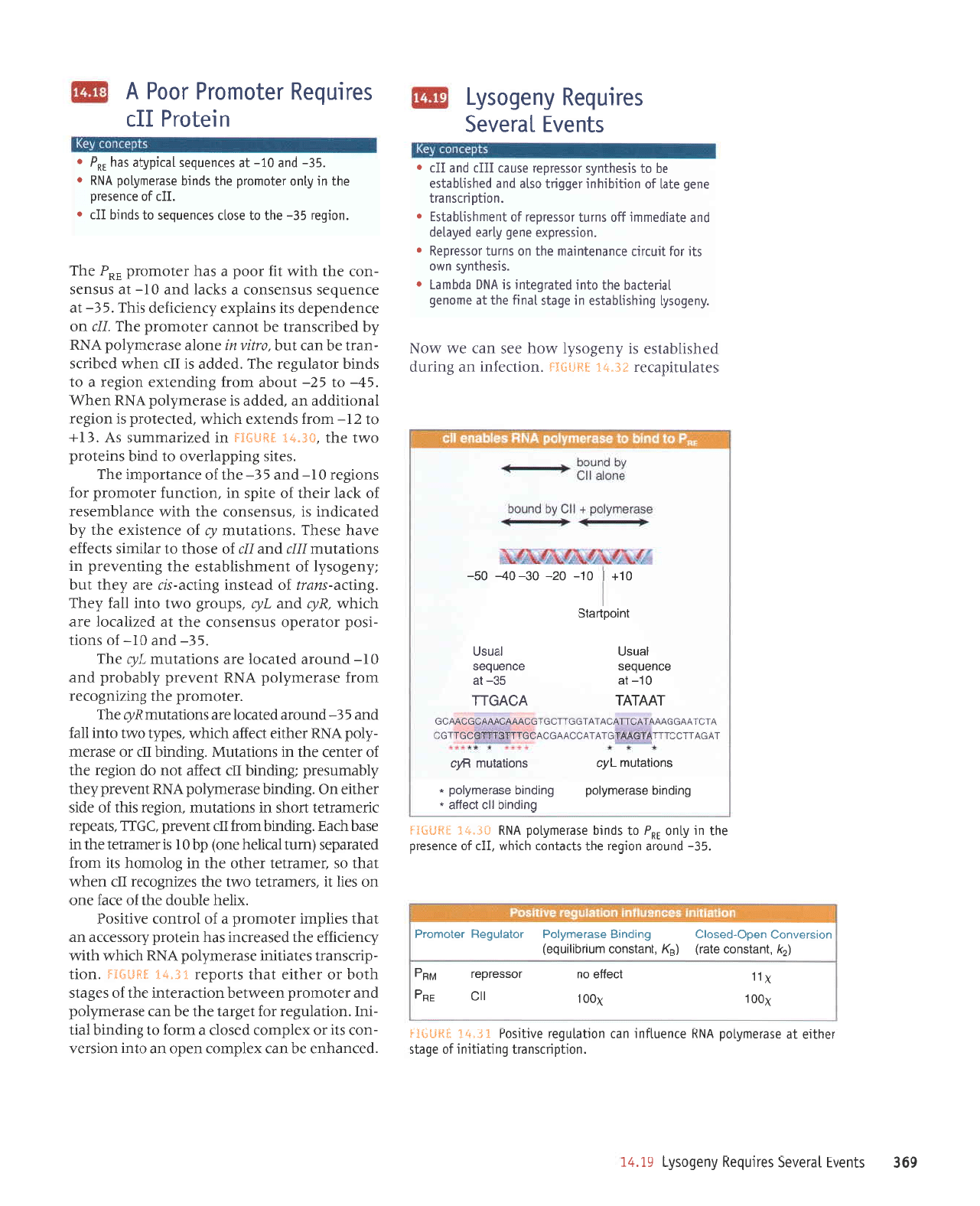
69€
slua^l
laa^as
salrnbau Aua6osr{1
61'71
'uorldursuerl
6urlerlrur
;o
a6els
raqlre
lp
aserauAlod
VNU
eruenlJur
uer uorlelnbar a^rlrsod
;{'gf
l&f}*gJ
xooI
xool
1c
]ud
x
I t
lcage
ou
.rosserder
nud
(21
'1ue1suoc
eler)
(e)
']uelsuoc
r-un;rqrgrnbe)
uorsronuoC uedg-pasog3
Ourpulg ase:aurI1o6 roleln6ag
JslouJoJd
'9€-
puno.rp
uorber aq1 slleluol
qrrqM
'IIr;o
eruesard
eq1 uL Aluo
lu;
o1 spurq eselauflod
VNU *g"t{ EH;1*U
salelnlrderal
f
t'5t
iE*$Id
'uolDeJur
ue Surrnp
pJr{srlqetse
sr Lua3os.d1 ,lroq
ees ueJ J,lr ,lroN
[ua6osr{1
6urqsqqelsa ur abels
lpug
aql
1e
euoua6
lpuallpq
aql olur
paletEalur
sr
ltrlfl
epQuel
o
'srsaqlu^s
uMo
sll ro1
lrnlln
olueuelurpur
aql uo sulnl
rossaldag
.
'uorssatdxe
auab fltee
par\e1ap
pup
olprpauurr
JJo
sutnl lossatdat
Jo
]uau{srlQplsl
o
'uor1d
ursuerl
aueb e1e1
jo
uoqrqrqur ra66u1
osle
pup peqsrtqplse
eq o1
srseqlufslosserdal
osnpl
IIII
pup
lll
o
'paJueque
aq uer
xalduor uado
ue olur uorsJJA
-uoJ
slr ro xaldruor
pesolJ
e uroJ 01 Surpuq
pE
-ru1
'uoqeln8JJ
roJ
tJBJpl
Jql Jq upl aseraruLlod
pue
Jelouord uaaa,tlaq uort)erJlur eql
Jo
se3e1s
qloq
ro raqlrJ
leq1
slrodJr
1['rT
;H{'}til
'uoll
-drnsue:l
selprlrul Jsprau^lod
VNU
qJrqM qlrm
druaoq;a aqt
pJSeJJJur
seq ureloJd,{.rossarre
ue
leql
sJIIdtm
rJloruord e
Jo lortuo)
JAIIISOd
'xlleq
alqnop eql
Io
e)PJ Juo
uo sell
1r
'sJJrueJlJl
oMl aql sazruSolar
tr)
uJq^t
leql
os taruerlel
raqlo Jql
ur Soloruoq slr ruoJJ
pelerpdes (urnl
prqaq
auo) dq
g
1
sr rJrrrplel
Jql r4
aseq
qreg
'3unuq
uroJJ
Ip
tuarrard
'3gg 'sleadar
JuJrupJlal
uoqs
ur suouplnru
'uor8ar
slql
Jo
Jprs
raqlrJ uO
'Surpurq
ase;aru.{1od
ygg
1ua,r.ard
daql
dlqerunsard lSurpurq
11r
DJJJe tou
op uofar aq1
Jo
JeluJJ Jql ur suorle1nry
'Surpurq
IIJ
Jo aseJeru
-d1od
ygg
JeqtlJ
DeJJp
qJIq
{
'sadrh
o.,tztl otur
[e]
pup
S€-
punoJp palplol
JJp suouplntuU/fJ
aqJ
'ratoruord
Jql SulzluSoJaJ
ruoJJ JspJeru,{lod
VNU
tua,rard
,{lqeqord
pue
0l-
punore pJlpJo[
Jrp suouplnu
7,{"r
aq1
'E€-
puP
0I-
Jo
suop
-rsod
JolpJJdo snsuasuoJ Jql
]e
pezrleJol
JJp
qrlqm
'yh
pue
7{c
'sdnot8
o.ttl olur
1ey
z(aq1
'Sutlte-suau
Jo
ppalsur
8u1De-sn a.re daql
tnq
1,{.ua3osz(1
Jo
lueuqsrlqelsa
Jqt
Surtuana:d ur
suorlelnu
111,
pue
IIJ
Jo
esoql 01 JEI[urs S1JJJJJ
e^Eq esJrII
'suorlplnru
f;
Jo
aruatsrxa
aql z(q
pJleJrpur
sr
'snsuJsuoJ
Jql
qlrM
a)uelqruJsJJ
Jo
>lJpl
Jreql
Jo
eUds ur
'uorlJunJ
raloruord
.ro;
suor8ar
0I-
pue
S€-
aq1
;o
aruegodrur
aq1
'satrs
EurddelJJ^o
ol
purq
suralord
o1!\l eqt
'Of"tg
3Hftslj
ur
pezrJeuuns
sv
'€I+
ol
Zv
uroJJ spuJlxa
qJlq^t
'paDalord
sr
uor8ar
Ipuoutppe
ue
'pappp
sr aseraur,{1od
VNU
uaq6
'SV-
ot
EZ-
tnoqp
ruor;
Supualxa uor8ar
e ol
spurq roteln8ar
aql
'peppe
sr
11]
urqu
pequJs
-ueJl
eq ueJ
1nq
'lJlttut
Juolp
aseJJrrr,{1od
ypg
.dq
paqrnsueJl
Jq
louupJ
raloruord
aqJ
'f,
uo
aruapuadap s1r sureldxa druartr;ap
slqJ
'E€-
tp
aruanbas
snsuasuoJ
p
s>lJpl
pue
0I-
l€
snsues
-uof,
Jql
qllM
llJ
rood e spr{ JatoruoJd
t*d
aqJ
'uor6ar
gg-
aql ol asoll sacuanbas
o| spurQ
[[r
o
'IIl
Jo
aluasalo
eq1 ut fi1uo raloLuold
aql spurq aserauflod
ypg
o
'98-
pup
OI-
le
seruenbas
lerrdr\1e
seq
ru6r
.
slua^l
lPra^as uralord
JII
0urpurq esereuAlod
suo[e1nur
1rfu
Ourpurq
1;c
lcege
.
6urpurq asereurl;od
*
suonelnu
pfu
-LVCVtrCC.LtrVIgWl0f Vf VCCVVCAVC9IJ*LOr
! r
9C01rCC
V-LCI.VVE
CVVV.TVCILVCV.LV.L9 9I.LC9I9CVVVSWVCOCVVCO
lVVIVI
0L-le
ocuonDes
lensn
luroouels
VCVEII-
9e-
le
ecuonbos
lensn
0t+
|
0r- 0z-
0e-0t- 09-
sarrnbou
r{ua6os^1
sajrnbau lalouojd
Jood
v
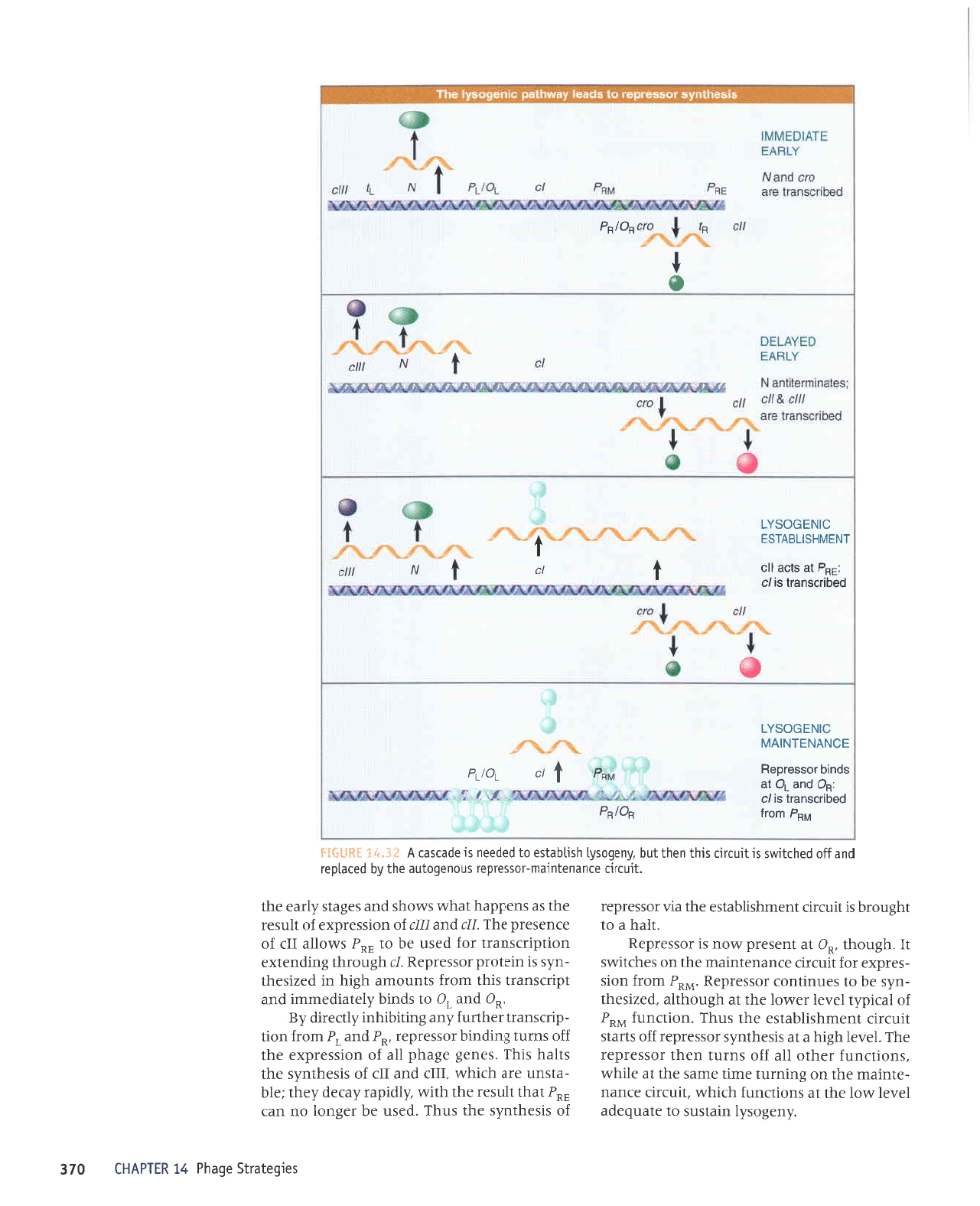
',{ua3os,{1
urelsns ot atenbape
Ia^al
lltol
Jql
le
suorlJunJ
r{JrqM
'llnJJrJ
eJueu
-elureru
Jql uo Sururnl
eurrl erues
eql
le
JIrqM
'suorlJunJ
rar{to
IIp JJo
surnl
uaql rossardar
rqJ'le^el
qBIq
e
1e
srsaqluds
rossardal
JJo
sUets
llnJJrJ luauqsrlqplse
aql snqJ
'uorl)unJ
wud
;o 1ettd,{.r IJAaI
reMol
aql
te
q8noqtp
'pezrseql
-u,{.s
aq 01 sJnurluoJ
rossardag
'wu4
uro.r; uors
-sardxa
roJ
lrn)rrJ
eJueuJlureur
eql uo seq)lrMs
11
'qSnoqr 'up
1e luasard.nou
sr rossardag
'lleq
P
01
tq8noJq
sr
lrnJJrJ luJruqs[qelsa
aqt en rossardar
sarbalerl5
a6eq6
71
UltdVHl
;o
srsaqluds Jqt snqJ
'pasn
Jq ra8uo1 ou ueJ
aud
teql llnser
eqr
qryn
.{prder
^derap ^aqt
lrlq
-elsun
JJe
qllqM
'IIIJ
puP
Ip
Jo
slsJqlu,{s aql
stleq srqJ
'saua8
a8eqd
IIe Jo
uolssardxa
aql
JJo
suJnl Surpurq
rossa.rdat
'"d
pue
fu
uorl uorl
-drnsuert
requnJ
Lue
3ur1lqqur,{prarrp
dg
'uo
pue
16
o1 spurq
Llatetpaunur
pue
ldrnsuerl
srql ruoJJ slunorue
qBH
ul
pazlseql
-u.{s
sr uratord rossa:dag'7r
q8norqr
Sulpuaxa
uortdrnsuen JoJ
pasn
eq ol
Eud
sMolle
IIJ
Jo
aruasard eql'77,
pue
ilp;o
uorssardxa
Jo
tlnsaJ
aqt se suaddeq
teqM
sMoqs
pue
sa8els,
.pea aqt
OLE
'lrnr.ln
elueueluletu-rossardar
snouebolne
eq1
fq
pareldar
pup
JJo
paqllrMs
sr
lrnllt]
slql
uaql
lnq
'r\ua6os[1
qsrtqplsa
01
papaou
sr
epe]spl
v fl[.F
t
3Hi]s].$
nH6l
LUO.r1
poqucsuerl
s!
/c
:ug
pue]g
1e
spurq losseroeH
3CNVNfINIVI/\J
ctNSoosAl
aorad
'
"IF
7
.?'
I
,"
1ot1d
poqucsuerl
sr
/c
:3Hg
1e
slce
;1c
lNlt/!HSt"lEVISl
ctNf cos^]
+p
t
ttlf
I{f Xt:!flf)EeEf]RfiXf.E5Ef.f,ErF]Sf
:lqtxf
trt[flTf.Ff.tff:tFrEfi,ql!3q
G
t
solad
